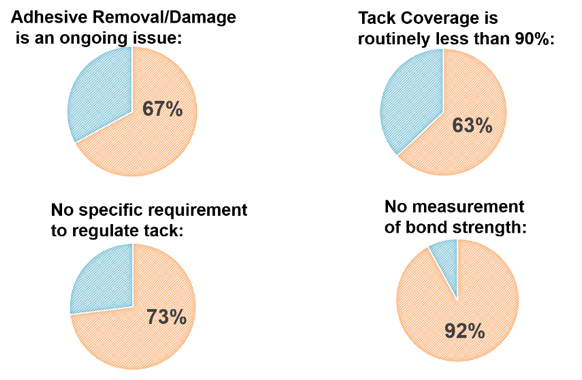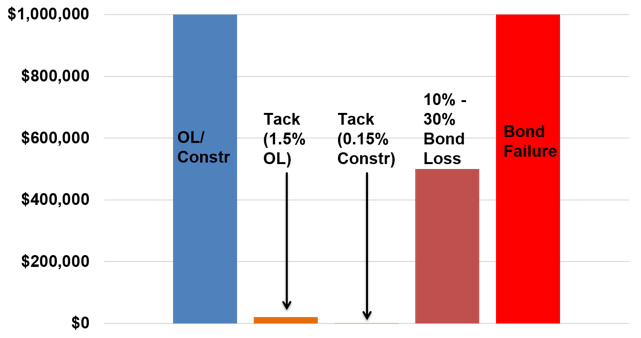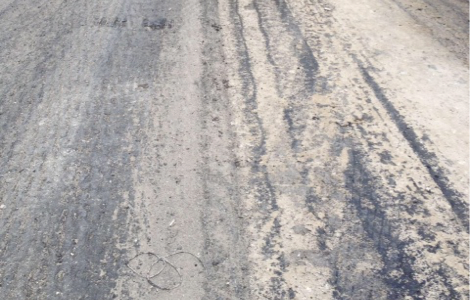Interlayer Bonding — Part III
In Parts I and II of this series, I spoke in depth about the importance of interlayer bonding, why it is often overlooked and the factors that impact tack coat application. Now, I will share the official stance of many asphalt experts relative to tack coat best practices, next steps for improving interlayer bonding in our industry, and conclude with accolades to the departments and agencies already making tremendous improvements in this area.
What the Experts Say
First, I want to review more evidence that reveals why the function of a tack coat is so critical.
Asphalt Institute (AI)
One of the most prestigious organizations in the industry, coordinated an all-out assault against poor tack coat practices—including a cover edition of their magazine and countless free webinars and workshops in all 50 states.
Federal Highway Administration (FHWA)
FHWA launched their own Tech Brief in April 2016 in conjunction with AI to reinforce AI’s message and bring awareness to the vital role that tack coats play in pavement construction.
National Cooperative Highway Research Program (NCHRP)
Another masterful effort devoted to this issue is NCHRP Report 712, published in 2012. One of the most valuable (and alarming) findings in this report is the impact of reduced coverage on bond strength, a common measure of tack coat quality. It was found that reducing tack coat coverage from 100% to 50% of the application area resulted in a 50% – 75% loss of bond strength! In fact, the same study showed that doubling the tack coat (in thickness) doesn’t really improve bond strength WHEN incomplete coverage or damage/removal of the tack coat occurs during the construction process. In other words, partial coverage or removal of the tack coat prior to placing the AC layer on top of the tack coat cannot be remedied by overcompensating with a thicker layer of tack coat.
The findings become even more compelling when combined with other studies – multiple mechanistic and empirical approaches presented here, here, and here have come to the basic agreement that a relatively minor bond loss (10% to 30%) compared to what was demonstrated in NCHRP Report 712 (50% – 75%) has substantial impacts on fatigue life – reducing it by as much as 50% to 70%! Combine all of this new information with the following straight from the highest authority – a survey of DOT’s, the Federal Highway Administration (FHWA), Field Engineers, Road Builders (contractors), AI, and other agencies reporting state of the practice relative to tack coat application:

All of this demonstrates that there is widespread knowledge and agreement of a major tack coat problem, and an ongoing lack of enforcement to rectify it.
If You Were Building Your House, What Would You Decide?
Pretend for a moment that we are not discussing a tack coat used in roadway construction, but rather a set of nails used in building a house. Both scenarios involve relatively cheap fasteners (nails / tack coats) that are designed to hold together more expensive materials (wood / AC roadway structure). Most builders understand that there are indoor nails and outdoor nails. Of course, the reliable outdoor nails are more expensive. They are designed to be highly resistant to corrosion and rust – essentially water-resistant.
If given the choice, would a homeowner choose to use cheap indoor nails on the exterior of their newly constructed home just to save a few bucks? Highly unlikely. Would the builder choose to use the cheaper nails to increase the bottom line? Maybe a corrupt builder with a short warranty period, but even this is unlikely. Even if a box of the highly durable outdoor nails is 3X the cost of indoor nails, it doesn’t matter – as a homeowner, it is not worth the risk of having your exterior fail prematurely; as a builder, it is not worth damaging your reputation as a quality builder. After all, the nails probably represent 1% or less of the cost of building materials, so why risk it? Why, then, in the road building industry do we focus on incorporating the cheapest tack coat materials that have no chance of resisting adhesive removal and are destined to cause premature failure? What is gained by using this approach?
How Our Industry Promotes Poor Tack Coat Practices
There are multiple issues, but here are four I’d like to highlight.
- The current low-bid process of road building encourages the use of inferior materials, such as tack coats that are highly susceptible to removal.
Remember earlier, when I stated that the issue of inferior bonding is one of the cheapest to remedy? Here is what I meant:

The tack coat is one of the cheapest items used in roadway construction (only 1.5% of a typical overlay project and 0.15% of a complete reconstruction project), but despite the negligible price tag, it is not uncommon to see an inferior tack coat product selected solely because it saves 0.5% on the project while potentially costing the tax payer over 50% in reduced lifespan.
- The road builder currently sees waiting for an emulsion to fully set as optional.
These specifications are not optional and were written by knowledgeable engineers whose primary job is to understand the importance of the glue between pavement layers. However, there is obviously a limit to how long a road builder should be expected to wait for a tack coat to fully set. Thirty minutes should be standard for tack coat setting under normal conditions, but, to further this problem, virtually every commodity tack coat listed in ASTM D3628 (MS-1, HFMS-1, SS-1, SS-1H, CSS-1, and CSS-1H) is not capable of fully setting within that time frame under normal conditions. The ASTM standard (2008) is so far behind modern technology that it promotes failing options for the engineer, agency, road builder, and taxpayer before the project even begins.
- The third reason for poor tack coat practices, in all cases, traces back to lack of QA enforcement by the Agency.
Since the removal and spreading of tack coat can create a mess, some agencies either avoid application altogether or apply it minimally (outside of wheel path locations). Considering the wheel path is the most critical location for tensile and shear stresses (don’t believe me, check out this NCHRP Report), this makes poor tack coat practices an engineering issue, not an aesthetic one.
Tell me this – will a tack coat or surface mixture properly bond to this?

Of course not! If this mud and dirt were on your deck, would you simply paint over it to complete your restoration project? No way. The mud and dirt act as bond breakers between the adhesive and roadway.
The above picture was actually taken by a member of Blacklidge’s Field Support Team in response to a customer who was concerned that our product was not working properly. It is our obligation when roadways fail prematurely to point out an obvious cause of the problem, defend the quality of our products, and promote best practices for road building.
4. Flexible pavements are still designed like it’s 1958.
The AASHTO design methodology—which is still used to this day by almost 80% of agencies and engineers—is based on data collected from a test track that was studied between 1958 and 1960. This method uses a conservative strength value to account for a worst case-type scenario. For example, the entire monolithic structure shown in Figure A here is deemed to be much weaker than it actually is.
National Center for Asphalt Technology (NCAT) studies in 2009 and 2014 sought to calibrate the strength values under the belief that too much conservatism is built into the original values. Of 14 sections that were analyzed in the study, it was found that only two had strength values at or below those recommended by AASHTO. And – wait for it – these two sections were trenched and the attributed cause of low strength was de-bonding in both cases! The study concluded that for most AC pavements (>5 inches thickness), AASHTO’s conservative approach results in 18.5% of surplus thickness added to the pavement. Think of the cost associated with this additional thickness over years for every pavement. Improving tack coat application accomplishes the same goal at a tiny fraction of the cost!
Model Agencies Making Change
Here’s the good news: there are some folks in the industry who do care about interlayer bonding and making progress. These are just a few examples:
- Florida DOT was one of the first to recognize the importance of interlayer bonding. That early focus eventually led to a mandate for non-tracking tack coat usage, a product specification and vetting system designed to prevent adhesive removal and extend the life of pavement overlays and structures.
- Virginia DOT recently instituted a similar mandate to FDOT that is still taking shape but looks promising in their efforts to eradicate tack coat adhesive removal from the state – a problem that has been widespread for the state of Virginia.
- The importance of interlayer bonding is certainly evident in Texas as the topic made both of TXDOT’s Top 10 lists: Top 10 Pavement Design Dos and Don’ts (No. 7) and Top 10 Ways to Get More Durable Pavements (No.’s 8 and 9)! The Texas Asphalt Pavement Association (TXAPA) also decided to host two non-tracking tack coat workshops in 2015. Blacklidge was invited and participated in both events. Further, Texas A&M Transportation Institute (TTI) performed an extensive investigation designed to screen for inferior tack coat products – products that have no chance of resisting adhesive removal. The findings from the investigation led to a pre-approved list of products known as Tracking Resistant Asphalt Interlayer (TRAIL).
- After the 2010 flood literally washed away many of the roadway surfaces in Nashville due to delamination between layers, a campaign to improve bonding was instituted. It was determined that all future roadways would be built with a superior bond, which means zero tolerance for adhesive removal. Even today, non-tracking tack performance must be demonstrated to the City of Nashville, or the bonding agent is not allowed. On slide 167 of the attached 2015 TCSA presentation co-presented by Mr. Donald Reid, Paving Operations Manager – Nashville Public Works Department, and Mr. Chad Collier, P.E., President – Collier Engineering Co., Inc., it is stated that non-tracking tack was the #1 improvement to their pavement management system over the last 5 years!
Now, we must understand and react to how interlayer bonding is interconnected with engineering design, construction, and materials selection. If we do not, debonding-related failures will continue to reduce the life of otherwise well-designed pavements. We should be beyond the debate of whether adhesive removal is acceptable. It is not. We now need to shift focus onto how thick the non-tracking tack coat layer should be for various applications, such as thin open-graded friction course (OGFC) or porous friction course (PFC) surface mixtures that are exposed to extreme shear stresses. It’s about time we accept how critical interlayer bonding is to our roads and do something about it.

It ‘s really great to know.Thank you for sharing.
I work for a municipal highway department. The “commissioner” refuses to use tack coat at all, and as a result our new roads have huge cracks and blowouts mostly along the shoulders after 6 months at maximum. I am doing this in the northeast where all 4 seasons including snow, ice and 90+ degree temps are hitting these untacked and unbindered roads. Taxpayers are getting ripped off in so many ways.